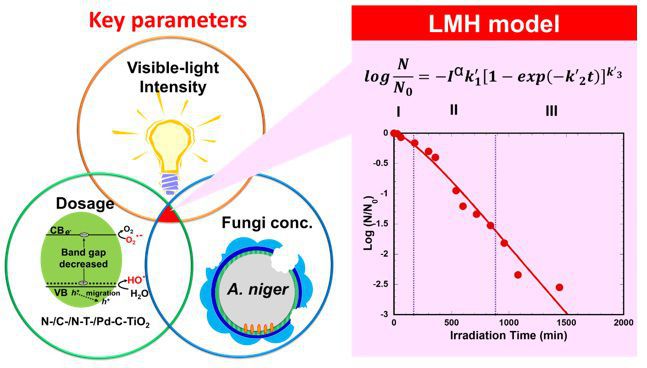| 論文篇名 | 英文:Kinetic study and performance comparison of TiO2-mediated visible-light-responsive photocatalysts for the inactivation of Aspergillus niger 中文:可見光感應型光二氧化鈦應用於黑黴菌失活的動力學研究和性能比較 |
| 期刊名稱 | SCIENCE OF THE TOTAL ENVIRONMENT |
| 發表年份,卷數,起迄頁數 | 2019, 692, 975-983 |
| 作者 | Shang-Ming Huang, Chih-Huang Weng, Jing-Hua Tzeng, Ya-Zhen Huang, Jin Anotai, Li-Ting Yen, Che-Jui Chang, Yao-Tung Lin* |
| DOI | 10.1016/j.scitotenv.2019.07.329 |
| 中文摘要 | 真菌具有極強的抗環境壓力能力。傳統的殺菌劑相當有效,但其使用率增加會引起嚴重的環境汙染問題。在這項研究中,使用可見光感應型催化劑,即N-TiO2、N-T-TiO2、C-TiO2和Pd-C-TiO2,比較其對黴菌Aspergillus niger (A. niger)進行消毒的性能。本研究探討影響消毒過程的關鍵參數,包括光催化劑劑量、初始真菌濃度和可見光強度。新開發的LMH動力學模型,結合可見光強度和光催化劑光吸收係數,首次用於預測真菌失活的光催化過程。在光催化劑中,Pd-C-TiO2對真菌的滅活性能最高,其次是C-TiO2、N-T-TiO2和N-TiO2。一般來說,失活效率與光催化劑劑量和光強度呈正相關,而與初始真菌濃度呈負相關。對於動力學建模,LMH 模型支持本研究之假設:光催化劑對可見光所驅動的真菌失活性能主要取決於光催化劑的光吸收能力。總而言之, LMH動力學模型可以有效預測由可見光感應型催化劑所驅動的真菌失活過程。 |
| 英文摘要 | Fungi are highly survived with exceptional resistance to environmental stress. Conventional fungicides are quite efficient, but the increase in use raises severe environmental problems. In this study, environmentally friendly TiO2-medialed visible-light-responsive photocatalysts, namely N-TiO2, N-T-TiO2, C-TiO2, and Pd-C-TiO2, were used to compare the performance of disinfecting a mold fungi Aspergillus niger. Key parameters, including photocatalyst dosage, the initial fungal concentration, and visible-light intensity, affecting the disinfecting process, was investigated. A new developed Light-responsive Modified Hom's (LMH) kinetic model incorporating visible-light intensity and photocatalyst light-absorption coefficient was firstly used to predict such photocatalytic process in fungal inactivation. Among the photocatalysts, Pd-C-TiO2 showed the highest inactivation performance against fungi, followed by C-TiO2, N-T-TiO2, and N-TiO2. In general, inactivation increased with increasing photocatalyst dosage and light intensity while decreased with increasing initial fungal concentration. For kinetic modeling, the LMH model supports the hypothesis that photocatalyst performance toward visible-light-driven fungal inactivation primarily depends on the light-absorption capacity of the photocatalyst. In conclusion, mold fungi Aspergillus niger are effectively disinfected by TiO2-mediated visible-light-responsive photocatalysts, and such fungal inactivation process could be predicted by LMH kinetic model. |
Kinetic study performance comparison of TiO2-mediated visible-light-responsive photocatalysts for the inactivation of Aspergillus niger 2019-07-21

新穎材料農業:友善環境農業新穎材料研發與安全評估【土環系林耀東特聘教授】






